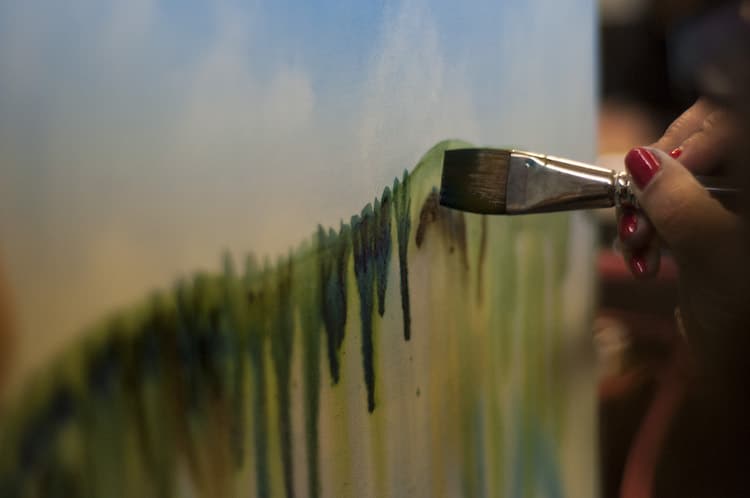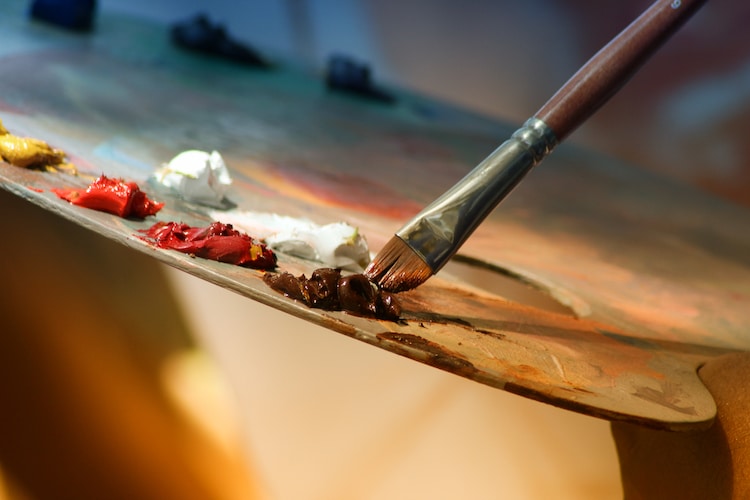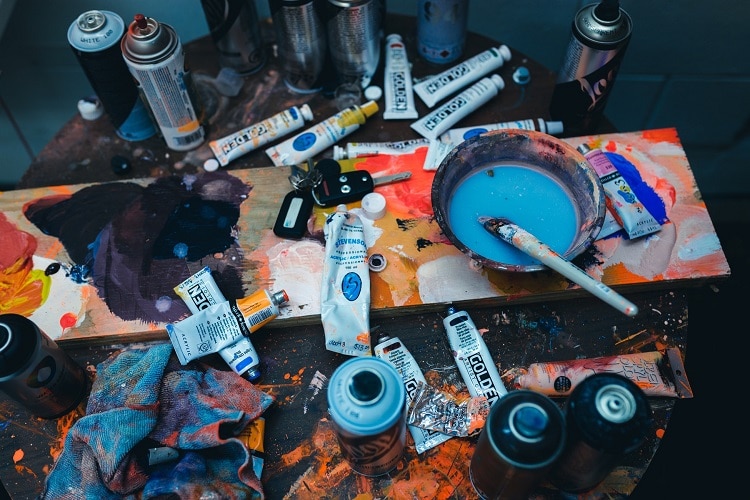
Photo: Shraga Kopstein
This post may contain affiliate links. If you make a purchase, My Modern Met may earn an affiliate commission. Please read our disclosure for more info.
There are many choices you can make when you begin to learn how to paint. The most basic is the kind of paint you’re going to use; three of biggest types are watercolor, acrylics, and oils. While it’s easy to distinguish the differences between watercolor paint versus acrylics and oils, it’s trickier to understand what separates the other two. They are often packaged in similar-looking paint tubes, but they have many differences. If you’re unsure of which paint you’d like to try, we’ll break down those differences, look at acrylic vs oil paint, as well as ways to hone your skills.
What is the Difference Between Oil and Acrylic Paint?
Though they look similar when squeezed out of a paint tube, there are fundamental differences in how the two paints are constructed.
Oils, in the art history sense, are classic. They were first developed in the 12th century and were used to create some of the most iconic paintings in history like the Mona Lisa and Van Gogh‘s Starry Night. The chemical composition features pigments that are suspended in oil (typically linseed). While timeless, they require a little more work to clean and maintain; they are not compatible with water, and so to thin or clean them, you’ll have to use turpentine or white spirit.
Acrylics, on the other hand, are much younger. They were first made commercially available in the 1950s and feature pigment suspended in acrylic polymer emulsion. Unlike oils, you don’t need any special chemicals to thin acrylics—just water will do. This aspect makes them great for beginners.

Photo: Tookapic
How Do Characteristics of Acrylic vs Oil Paint Compare?
Drying Time
One of the biggest differences between the two paints is their drying time. Oil paints dry slowly. It can take days before the pigment fully sets, and it allows you to step away from a work in progress and come back to it at a later date. When you do, you can pick up where you left off. Because they are so malleable, they work well in realistic-style paintings—you can push the paint and blend it so that transitions look seamless.
Acrylics, on the other hand, dry very quickly. In some instances, it can take just a couple of minutes for them to be set. If you’re working in a graphic style or prefer to finish your painting in one sitting, acrylics are the way to go.
Lightfastness
Lightfastness is the property that describes how fast a color will fade when exposed to light. Oils and acrylics respond differently to light conditions.
Oil paints will fade over time. If you’ve ever seen an old painting, you might notice that they appear yellow; this is because the pigment grows visually duller over time and the oil binder shows through.
Acrylics have excellent lightfastness. They look the same now as they will many years from now in the future.
Ability to Experiment
This is one of the most striking variations between oil and acrylics—and one where acrylic paint is clearly on top.
Acrylic paint is known for its ability to experiment. Called mediums, these substances are mix-ins that allow acrylics to take on special properties that they wouldn’t otherwise. You can, for instance, incorporate mediums that make the paint really thick (for palette knife paintings) or ones that slow the drying time and make acrylics behave more like oils.
Oil paints don’t have this same flexibility. So, if you like working in mixed media or have ever thought about experimenting with the viscosity of pigment, you’ll want to go with acrylic on this one.

Photo: Alicia Zinn
How Do You Know What Paint Is Best For You?
Given what we know about the two paints, you can now determine what’s best for you. So, ask yourself; What kind of paintings are you trying to create? Are you going for something that’s experimental and more design oriented? If so, then go for acrylics. But if you’re looking for traditional painting styles that are realistic, oil paint is the best choice.
Another consideration is where you’re going to work. Oil paints are a luscious pigment, but they can be smelly—especially the substances you use to clean your brushes. Make sure that if you working with them, you are in a well-ventilated area.

Photo: Daian Gan
Paints That Artists Love
Ready to begin painting? Whether you’re starting with oil or acrylics, here are some highly-rated sets you can try.
Oil Paints
- Bellofy 24-Color Oil Paint Set, $8.97: A professional set that has 24 hues in 12mL tubes. This makes it great for beginners or artists who want to travel with their paint.
- Winsor & Newton Winton Oil Colors Set, $25.47: One of the most recognized paint brands, this 10-color set includes all the basics you’ll need in 21mL tubes.
Acrylic Paints
- Winsor & Newton Artist’s Acrylic, $13.99: A great set for beginners and professionals alike, this set offers pigments in a buttery consistency while still retaining the quick-drying qualities of acrylics.
- Liquitex Basics Acrylic, $34.27: Eager to try mixed media? In addition to traditional painting techniques, this set was made for experimenting with non-painting approaches.
For more information on the best acrylic paint sets, check out our detailed list.

Photo: Caleb Salomons
Learn How to Paint Online
Skillshare is one of our favorite places for online learning. Below is a bevy of classes that will help you develop your oil or acrylic painting skills.
Classes for Oils
- The Oil Painter’s Handbook
- Guide to Non-Toxic Oil Painting Methods
- Oil Painting- Learn the Zorn Limited Color Palette
Classes for Acrylics
- Acrylic Painting: Learn the Basics for Beginners
- Modern Acrylic Painting: Explore Techniques to Create On-Trend Art
- Acrylic Painting: How To Paint An Abstract Landscape
Related Articles:
10+ Famous Watercolor Artists Who Continue to Influence Painting Today
17 Artists Blurring the Line Between Painting and Photography
8 Best Acrylic Paint Sets That Both Beginners and Professional Artists Will Love
